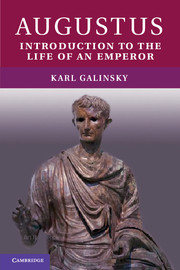Book contents
- Frontmatter
- Contents
- List of Maps, Genealogical Chart, and Illustrations
- Maps & Genealogical Chart
- Timeline
- Note on Major Ancient Sources
- Preface
- 1 From Velitrae To Caesar’s Heir
- 2 Power Struggles and Civil War
- 3 The Experiment of the Principate
- 4 The Challenge of Pax Augusta
- 5 Augustus at Home
- 6 Cultural Vitality
- 7 The Augustan Empire
- 8 The Final Days and an Assessment
- Select Bibliography and References for Further Reading
- Index
- Index of Passages and Inscriptions
4 - The Challenge of Pax Augusta
Published online by Cambridge University Press: 05 February 2013
- Frontmatter
- Contents
- List of Maps, Genealogical Chart, and Illustrations
- Maps & Genealogical Chart
- Timeline
- Note on Major Ancient Sources
- Preface
- 1 From Velitrae To Caesar’s Heir
- 2 Power Struggles and Civil War
- 3 The Experiment of the Principate
- 4 The Challenge of Pax Augusta
- 5 Augustus at Home
- 6 Cultural Vitality
- 7 The Augustan Empire
- 8 The Final Days and an Assessment
- Select Bibliography and References for Further Reading
- Index
- Index of Passages and Inscriptions
Summary
Some myths die hard. The issue, in the Augustan context, is not the myth of the Golden Age itself, but the myth of the Augustan Golden Age. The entire period of Augustus’ reign has often been characterized with this label which, as most labels, is convenient rather than precise. On that view, the last ripples on the Augustan sea were those of the battle of Actium. Calm then prevailed, prosperity returned, problems receded if not evanesced, splendid new edifices arose, and the arts flourished. Especially in ever-increasing retrospect, it was a blessed time that led later ages, notably in France, England, and Saxony, to appropriate the seal of an Augustan Golden Age for themselves (cf. Box 8.2).
As always, the reality was more complicated. We already saw in the last chapter that there were choppy waters on which Augustus needed to navigate. Things fell into place neither automatically nor providentially after Actium and Alexandria. And how could they? The decades of disarray, amounting to almost a century, had left deep marks and fissures. A return to stability would require considerable time and always be a work in progress. That is, in fact, the mindset we find in many of the contemporary sources: not facile self-congratulation, but awareness of the need for ongoing effort. Vergil’s Aeneid is a sterling example. It is about the founding of Rome, but not in the physical sense. In the national epic, Rome is of course not built in a day – in fact, it is not built at all. That will come later; the emphasis is on the exertions (labores) and struggles of the founding father.
- Type
- Chapter
- Information
- AugustusIntroduction to the Life of an Emperor, pp. 84 - 109Publisher: Cambridge University PressPrint publication year: 2012



